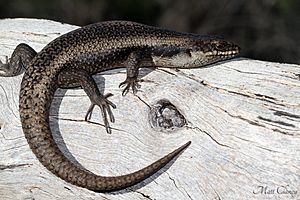Tree-crevice skink facts for kids
Quick facts for kids Tree-crevice skink |
|
|---|---|
 |
|
| Conservation status | |
| Scientific classification | |
| Genus: |
Egernia
|
| Species: |
striolata
|
| Synonyms | |
|
|
The tree-crevice skink or tree skink (Egernia striolata) is a type of skink. Skinks are lizards that belong to the family called Scincidae.
This skink is found only in Australia. You can see it in the states of Victoria, the Northern Territory, Queensland, New South Wales, and South Australia.
Contents
What Does the Tree Skink Look Like?
The tree-crevice skink is a medium to large lizard. It has a dark, brownish-grey body. A light stripe runs from its head to the start of its tail.
Sometimes, it has small white spots on its back. Its belly is often yellow or light orange. The underside of its legs and tail are usually white or grey. A dark band goes from its eye to its back legs.
Where Do Tree Skinks Live?
The tree skink is native to Australia. It lives in the dry areas of Western Australia. You can find it from the Pilbara region down to the Great Victoria Desert.
It does not live on the coast or in very high mountains. It is also not found in central and eastern Queensland.
Tree Skink Habitat and Habits
The tree skink mostly lives in trees. It likes to hide in hollow logs and cracks in trees. You can also find it behind the bark of standing or fallen trees.
Sometimes, in New South Wales, they live among rocks. In South Australia, they often use rocks and tree cracks. They have even been found under the "skirts" of certain grass trees. These skinks can also live in places changed by humans, like fence posts.
Tree skinks often live together in small groups. These groups usually have 2 to 4 skinks. They have a special way of recognizing each other.
Tree Skink Reproduction
Tree skinks have their mating season in September and October.
How Are Tree Skinks Doing?
The Egernia striolata is listed as "Least Concern" by the IUCN Red List. This means its population is stable and not currently at risk. There are no special plans needed to protect them right now.
See Also
 In Spanish: Egernia striolata para niños
In Spanish: Egernia striolata para niños


